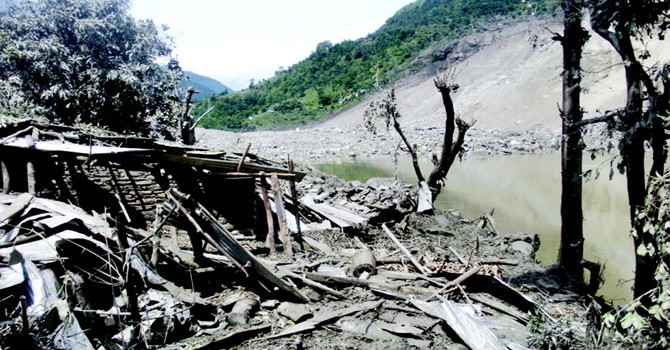Disaster preparedness of security organs to avert casualty, loss

By A Staff Reporter
Kathmandu, Nov. 11: Over 900 human lives were lost in over 6,000 disaster incidents in 2017 and 2018.
Nepal Disaster Report-2019, made public on November 4, stated 968 human lives were lost in 6,381 disaster incidents in the last two years.
If the report of the loss of human lives and properties as stated in the National Emergency Operation Centre (NEOC) is anything to go by, around 484 persons perish in disasters annually.
Further, the Ministry of Home Affairs also made public its ‘Monsoon Emergency Work Plan,’ to be executed every monsoon season for making better preparedness, rescue, and relief works by the three security bodies to combat the possible human casualties and loss of property.
The report had also stated that property worth Rs. 6.84 billion was destroyed and 3,639 people left with injuries in the disasters in two years.
Water induced disasters had caused significant damages and losses during the monsoon. Fire incidents followed by lightning have increasingly claimed lives and caused loss to property.
Against this backdrop, the three security bodies – Nepal Police, Nepali Army and the Armed Police Force (APF) -- also prepared and kept their disaster combating equipment standby position with their trained human resources for 24 hours, according to the officials from the security bodies.
As per the details submitted by the three security bodies in the emergency work plan 2019, the Nepali Army, the frontline rescuers in any type of disaster, had deployed 1,573 personnel during this year’s monsoon.
The details of the human resources of Nepali Army were submitted to the Ministry by the NA as per the work plan. The NA has its own Disaster Risk Management Directorate Office.
According to the details of the work plan report, the NA had their five acrow bridges provided by the US government, two Riverine boats, 52 outboard motor (OBM) boats, 34 IB boats, and 33 rubber boats for its mobilisation at any time and situation.
Acrow bridge is designed with prefabricated modular steel bride components, which can be easily customised to the desired length, width, and strength, allowing for diverse applications and uses.
The NA has also been keeping their air services in standby position in Itahari, Kathmandu and Surkhet for conducting any type of rescue operation, and 104 military forces (equivalent to a company) of the NA in ready position for their immediate deployment in any disaster hit district, according to the report.
Similarly, the Nepal Police used their 80 personnel in Karnali State, 155 in States 2, 3, Gandaki, 5 and Karnali and 205 in State 1.
Additionally, the Police Headquarters used its extra 260 human resources and 100 from the Metropolitan Police Office, Ranipokhari, during this monsoon season.
Nepal Police have 18 heavy equipment that can be mobilised in case of any emergency in States 1, 2, 3 Gandaki and 5 and have no any equipment in Karnali and Sudurpaschim States, according to
the report. Nepal Police have just nine rubber boats across the country. Meanwhile, the Armed Police Force (APF) mobilised nearly 2,376 human resources for the monsoon season of this year in all seven States and had deployed, according to Deputy Inspector General and spokesperson at APF Headquarters, Suraj Kumar Shrestha.
The APF has also its over 900 trained disaster preparedness personnel in ready position. Also, the APF has its 56 human resources for conducting search and rescue for collapsed structures, 24 fire fighting equipment, 16 rappelling climbing equipment, 25 deep divers, nine inflatable rescue boats with outboard motors, 22 rescue rafts and 13 heavy equipment.
According to DIG Shrestha, the APF has its Special Task Training School in Saptari for preparing their hydro-meteorological disaster rescuers, Sinamangal-based Disaster Rescue Battalion and Disaster Management Training Centre, Kurintar.
The Ministry has been operating the National Emergency Operation Centre (NEOC) at the central (federal level), State Emergency Operation Centre (SEOC) in the States, District Emergency Operation Centre (DEOC), and Local Emergency Operation Centre (LEOC) to conduct any kind relief-rescue operation.
According to Bedh Nidhi Khanal, under-secretary and focal person at the national emergency operation centre, more than 80 per cent of the total population in Nepal are at risk of natural hazards, such as floods, landslides, windstorms, hailstorms, fire, earthquake, and Glacial Lake outburst Floods (GLOFs).
He said these facts had placed Nepal among the 20 most disaster prone countries in the world.
A review of disaster data for last 45 years indicated that the incidences of disasters are growing every year in Nepal.
Recent News

Do not make expressions casting dout on election: EC
14 Apr, 2022
CM Bhatta says may New Year 2079 BS inspire positive thinking
14 Apr, 2022
Three new cases, 44 recoveries in 24 hours
14 Apr, 2022
689 climbers of 84 teams so far acquire permits for climbing various peaks this spring season
14 Apr, 2022
How the rising cost of living crisis is impacting Nepal
14 Apr, 2022
US military confirms an interstellar meteor collided with Earth
14 Apr, 2022
Valneva Covid vaccine approved for use in UK
14 Apr, 2022
Chair Prachanda highlights need of unity among Maoist, Communist forces
14 Apr, 2022
Ranbir Kapoor and Alia Bhatt: Bollywood toasts star couple on wedding
14 Apr, 2022
President Bhandari confers decorations (Photo Feature)
14 Apr, 2022











